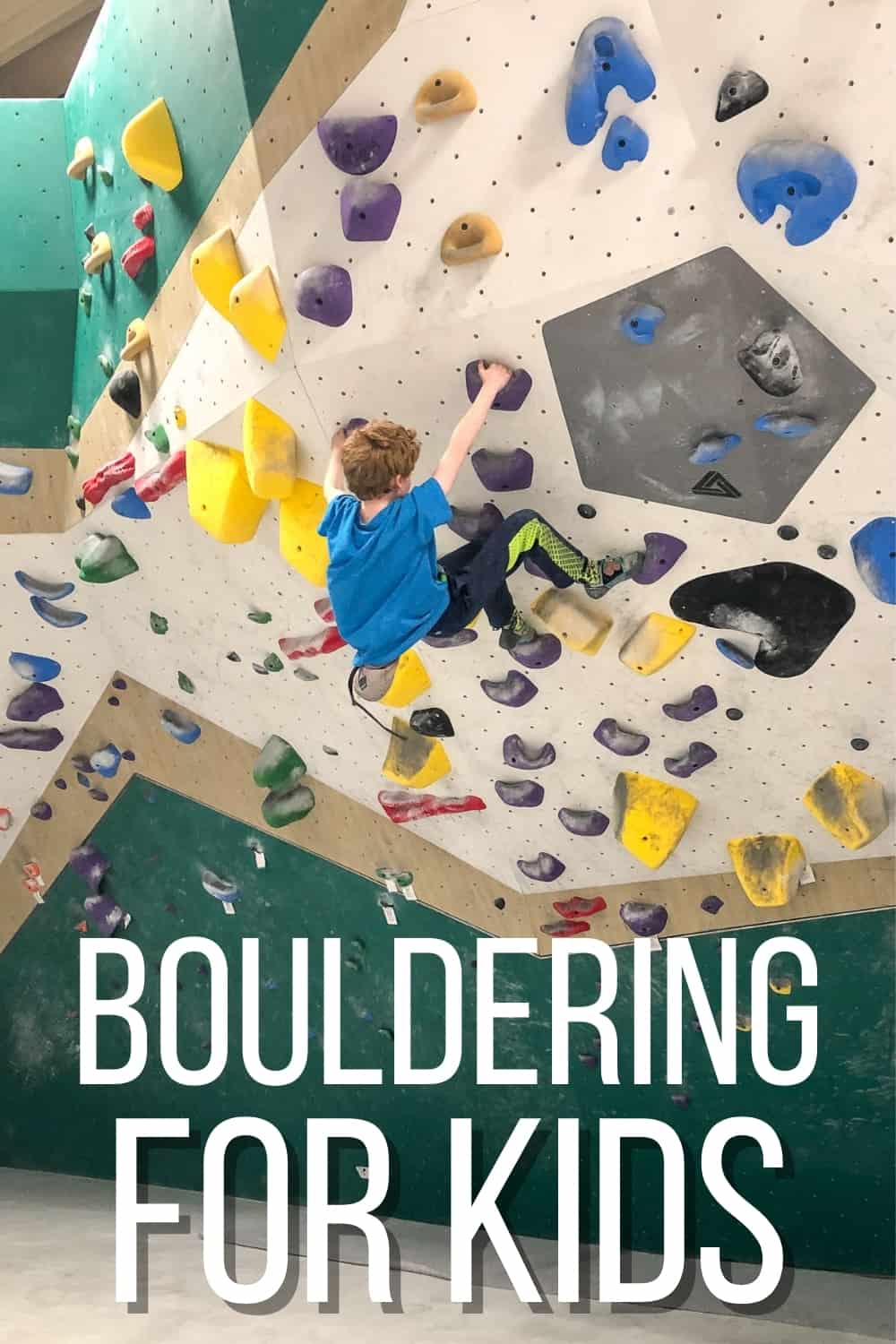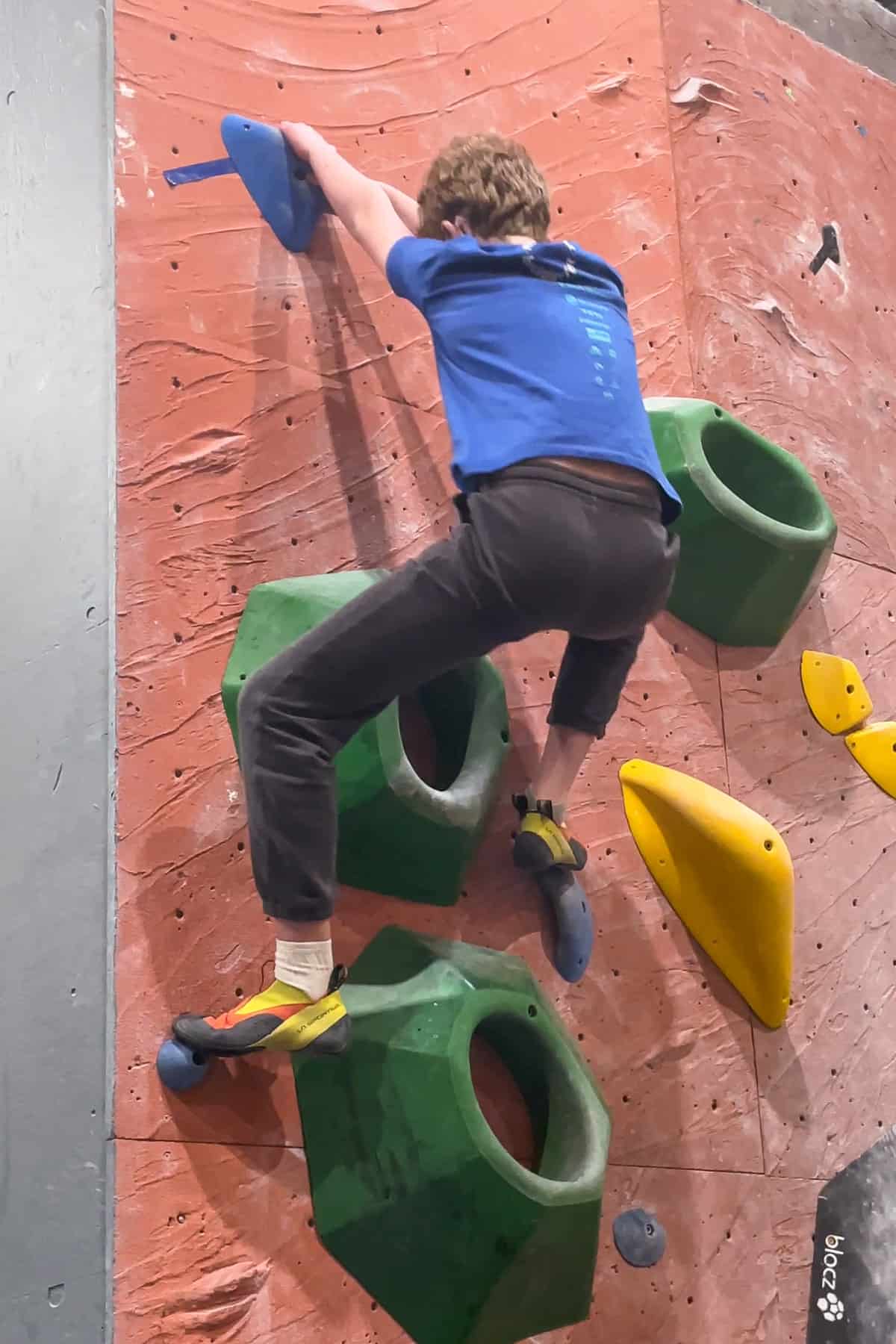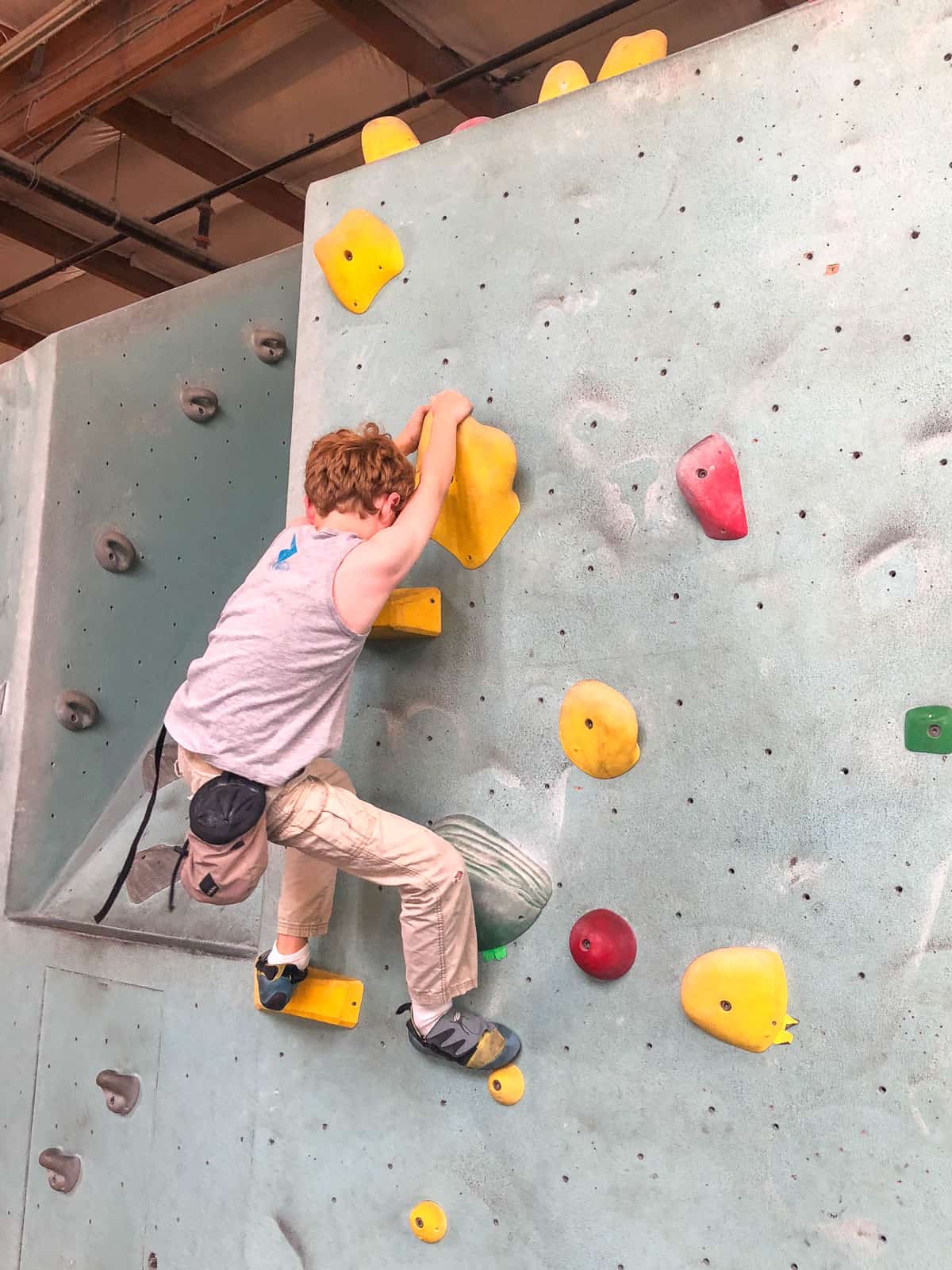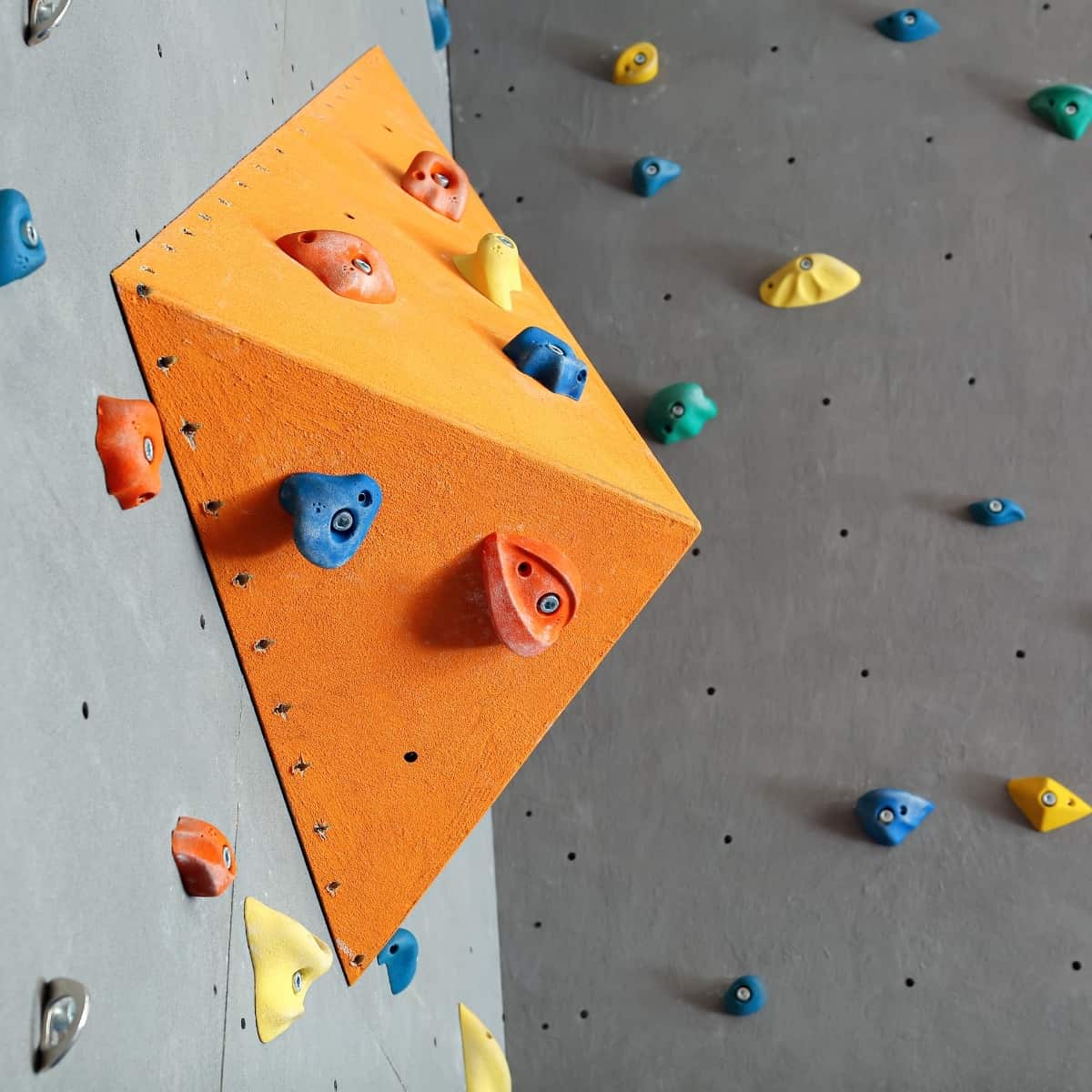Introduction to Bouldering for Kids
What is bouldering, and is it safe for kids? I’ll answer both these questions in this introduction to bouldering guide!

Whenever I explain bouldering to another mom, their eyes get wide and they probably start questioning my sanity! How could I possibly let my only child climb 15 feet up in the air without a rope?!?
But if your child learns to climb (and fall) safely, the risks are fairly minimal. My son goes to the climbing gym several times a week for the last five years, and has never been seriously injured. (Knock on wood!)
This post contains affiliate links for your convenience. Purchases made through these links may earn me a small commission at no additional cost to you.
What is Bouldering?
Bouldering involves climbing set routes on walls up to fifteen feet tall, with a thick pad underneath to cushion a fall. Many gyms have wall-to-wall padding that feels like you’re walking on a marshmallow!

Different Colors for Different Routes
When you walk into a climbing gym for the first time, you’ll see a rainbow of colors on the walls. What could be more enticing for kids?
Each route will be color coded, and you should only use the colored holds for that route when you climb. The difficulty will either be labeled with a tag at the start, or by the color chart posted at the gym.
Some gyms will use the same color for all the routes of a certain difficulty. For instance, all the yellow routes are the easiest, and all the pink routes are the hardest. There should be a chart somewhere at the gym that explains their color coding system.

Other gyms will post the difficulty level right next to the start hold. In the United States and other parts of the world, they use the V scale to indicate how hard the route is to complete. Even the smallest kids can usually reach all the holds in a V0 route!
Sometimes the holds will all be different colors throughout the route, but they’re all marked with the same color tape. If you’re confused about how the routes are set up, ask someone at the front desk for help!
Two Ways to the Top
In order to claim victory over a route, there’s two different ways to “top” it.
The most common way to complete a bouldering route is to touch the top hold with two hands. Technically, you need to have full control of the hold with both hands for it to count. Usually the top hold will be marked with a piece of tape or will be labeled FINISH.

The other way to top a boulder is to climb up and over. These top-out boulders will have a walking area along the middle with a staircase or ladder so you can get down. In the photo below, you can see how the yellow holds go up and over the top of this boulder, with a downclimb area right next to it.

Volumes
You’ll probably notice some climbing elements protruding from the walls that don’t have a specific route color. These are called “volumes” and are added to the climbing wall to create different angles on the flat surface.
The large orange shape on the wall in the photo below is a volume. You can place your hands or feet anywhere on the surface where there’s not a colored hold, just like the wall.

Unless they’re specifically marked for a certain route, all volumes are “on.” Which means you can use them for any route! Don’t forget to point this out to your child, especially if they’re struggling with a route that’s marked as easy. Treat the volume like a part of the wall itself!
Bouldering Gear for Kids
Luckily, you don’t need to go out and buy a bunch of stuff to take your kids bouldering at a gym for the first time!
Kids Climbing Shoes
Most kid friendly climbing gyms will have shoes for rent in even the smallest of sizes. This is a great way to see if your child likes climbing before you invest money into buying their own pair.
Once your child starts climbing regularly, they’re probably going to want their own shoes. Plus, the rental fee starts to add up when you climb more than a few times a month!
Some kids prefer slipper-like shoes, and other like a stiffer sole so pointy holds don’t hurt the bottom of the foot. It helps to find a place like REI where they can try on a bunch of different options.
When my son was really little, he loved these Mad Monkey shoes. Their sizing goes all the way down to toddler size for even the smallest of climbers! The Velcro straps make it easy to slide the shoes on and off, and allow you to adjust the fit.
Chalk
Honestly, my son hates the feeling of chalk on his hands, and doesn’t use it much. But if you live in a humid environment, you may find that the holds become slippery from moisture and cause your child to fall more easily.
Powder chalk is more common, and should be contained in a chalk bag at all times. Some gyms require powder chalk to be encased in a fabric ball, so it doesn’t spill all over the mats.
Liquid chalk looks like sunscreen that stays on top of the skin, and makes your hands dry and a little sticky. Some climbing gyms require only liquid chalk, so the air doesn’t become filled with dust.
Chalk Bag
Chalk bags hold powdered chalk in a pouch that is strapped to the waist like a belt. There are a ton of different designs and styles available, including these super cute monster face ones!
Chalk bags are one of the few pieces of climbing gear that shows off your kid’s personality, so let them choose a fun one! Just remember to cinch it closed before you toss it in the car, or you’ll have chalk all over the backseat (ask me how I know!)
Bouldering Safety
Bouldering can be dangerous. Even the safest climber can be hurt by a bad fall! But there are plenty of things you and your child can do to make sure no one gets injured.
Start by watching this great video on falling safety, then check out the tips below.
Take an Introduction to Bouldering Class
If you’re not comfortable just diving into the sport without any instruction, take a class first. These introductory classes will teach you how to fall safely, how to avoid other people falling on you, and how to climb effectively.
Fall Safely
It may seem impossible, but there’s a right and a wrong wall to fall off a bouldering problem. Once you get the hang of it, the correct falling technique becomes second nature!
Basically, you want to fall with your feet pointed down and knees bent and loose. When you hit the ground, roll onto your back with your arms across your chest and your neck tucked in. Remember, you don’t get points for sticking the landing!
Also, don’t try to break your fall by grabbing onto holds on the way down. If you’re falling onto the wall, try to push away from it instead.
Remove Jewelry and Accessories
Necklaces, belt buckles and other hard items will hurt when you fall on them. You should also keep key chains and phones out of your pockets.
Look Up When Walking Around the Gym
Remember that most of the action is happening above your head, so keep your eyes up when walking around the gym. This is especially important for younger children, who might need to be reminded to stay aware of people above them.
As a general rule, you should keep at least six feet from the climbing walls. This will give climbers on the wall plenty of room to fall or jump from a completed route without landing on top of you.
Don’t Run in the Gym
Don’t let your child run around the gym, doing flips or somersaults on the mats. While it may be tempting to turn those squishy mats into a gymnastics studio, don’t!
When the gym gets busy, there’s limited room to walk around safely. Stay safe and don’t frustrate other climbers by letting your child run wild.
Don’t Cross Routes with Other Climbers
Read the route all the way to the top, taking note of where your route crosses another. If someone is already working a route that crosses yours, wait until they’re finished before starting. The climber on the wall has the right-of-way!
Always Downclimb
When you complete a route, it can be tempting to leap from the finish hold to the ground. But this can lead to twisted ankles and knees when landing on the soft mats.
Instead, use any holds to climb down to the ground. Sometimes there will be specific downclimb holds that are easy to grab as you make your way down the wall. Use them!
I hope this introduction to bouldering for kids is helpful! As a parent, it can be nerve-wracking watching your child scale a wall without a rope. But once you learn to trust your child’s abilities, it’s really amazing to see how well they adapt to vertical movement!